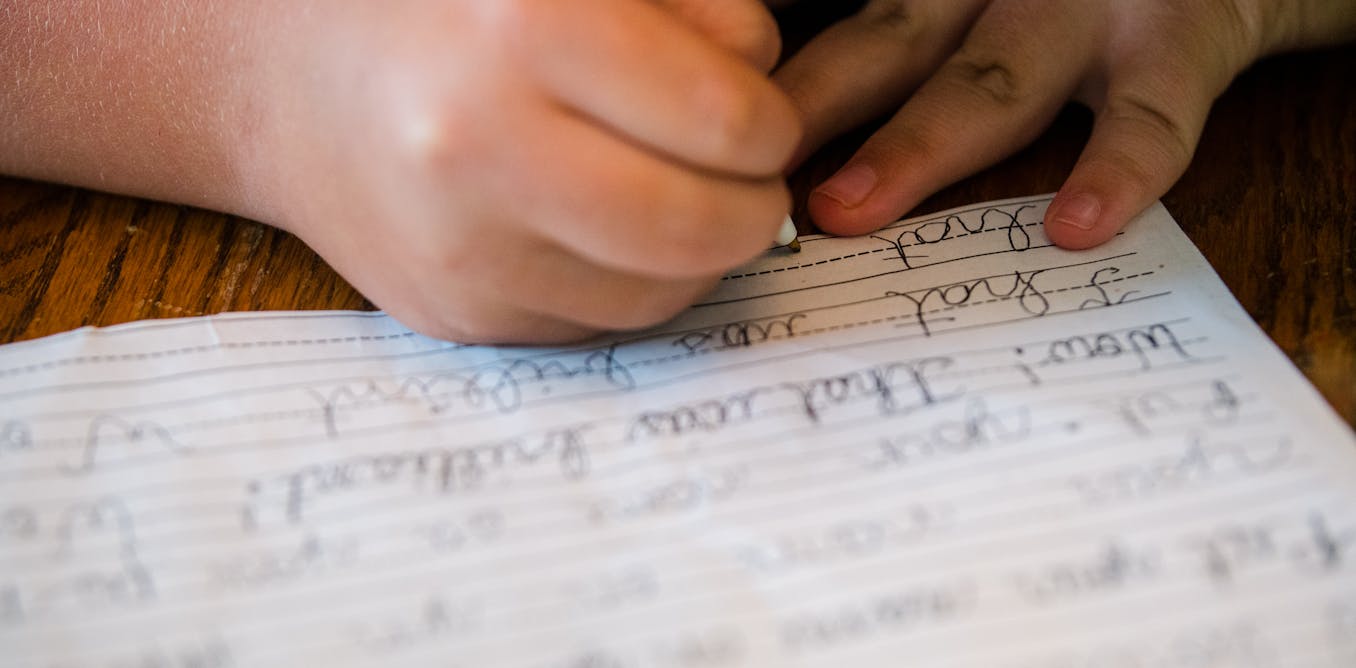Recently, my 8-year-old son received a birthday card from his grandmother. He opened the card, looked at it and said, “I can’t read cursive yet.”
Then he handed it to me to read.
If you have a child in the Philadelphia School District, chances are they have not been taught how to read or write cursive either.
But cursive handwriting is making a comeback of sorts for K-8 students in the United States. Several states in recent years passed legislation mandating instruction in cursive handwriting, including California, Iowa and Oklahoma.
Pennsylvania and New Jersey are considering similar legislation, as are other states.
I’m an associate professor of special education and the director of the Iowa Reading Research Center. At the center, we’re conducting a systematic review of prior research to improve cursive handwriting instruction.
We also want to know how learning cursive affects the development of reading and writing skills.
Cursive instruction sidelined
In cursive handwriting, the individual letters of a word are joined with connecting strokes, such as in a person’s signature.
Cursive fell out of favor in U.S. schools over a decade ago. In 2010, most states adopted Common Core academic standards which omitted cursive handwriting from expected academic skills to be learned by K-8 students. In fact, the standards only briefly mention print handwriting, a writing style in which the individual letters of a word are unconnected, as a skill to be taught in early elementary grades.
Educators often have trouble finding enough time in the school day to teach all the expected writing skills, let alone something that’s not mandated such as cursive handwriting.
In several national surveys, teachers have reported limited amounts of time for writing instruction and that they have found it difficult to address both the basic skills of writing, such as handwriting, and more advanced skills, such as essay composition.
Benefits of handwriting
The increased interest in cursive handwriting likely stems from effort by policymakers to improve the literacy performance of K-12 students across the country.
On the National Assessment of Educational Progress reading assessment, a measure of nationwide reading progress, only 31% of fourth grade students scored proficient or above. Philadelphia’s numbers were worse, with just 19% of fourth grade students scoring proficient or above.
Research suggests it may be possible to improve overall writing and reading through handwriting instruction.
The benefits have been more closely studied with print handwriting, but preliminary evidence suggests cursive handwriting instruction may also be beneficial. Some studies have found cursive handwriting instruction can improve handwriting legibility, writing length and select reading skills. In a 2020 study, researchers found cursive handwriting instruction can also improve spelling accuracy and storytelling ability.
Why might cursive make a difference? On the surface, it seems like a simple motor skill. But under the surface, cursive handwriting draws upon deep reading knowledge and requires the coordination of multiple cognitive and physical processes.
To handwrite letters or spell words in print or cursive, students need to commit multiple aspects of each letter to memory. For example, if students handwrite the word “cat,” they need to know the overall shape of each letter, as well as its name and sound.
After drawing upon this reading knowledge from memory, students use a combination of motor and vision systems to write each letter and the entire word. Gross motor movements are used to adjust the body and arm to the writing surface. Fine motor movements are used to manipulate the pencil with one’s fingers. And visual-motor coordination is used to write each letter and adjust movements as needed.
Douglas Sacha/Moment Collection via Getty Images
A skill with staying power?
Besides potential benefits to overall writing and reading development, cursive handwriting continues to have social importance.
It is often used to sign formal documents via a cursive signature, or to communicate with close friends or loved ones. Furthermore, understanding cursive is needed to read important historical documents, such as the Declaration of Independence.
Even in the digital age, touch-screen tablets and other devices often come with the ability to handwrite text with an electronic pencil. I teach courses at the University of Iowa, and many of my students handwrite their notes on electronic tablets.
For schools, low-tech options such as paper and pencils remain more cost-efficient than high-tech options. For example, it can be time-consuming and expensive to replace a broken laptop but relatively cheap to sharpen a broken pencil or get a new piece of paper.
Although it may be difficult for educators to find sufficient time for writing instruction, students will likely benefit from developing the capacity to express their ideas in a variety of ways, including cursive handwriting.
For anyone interested in learning about cursive handwriting and teaching it to their children or students, the Iowa Reading Research Center will release a free online course and curricula called CLIFTER on June 2, 2025.
Read more of our stories about Philadelphia.




